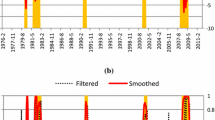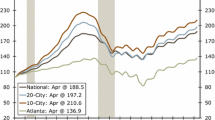Abstract
After the Global Financial Crisis, the U.S. housing market has been studied extensively from several dimensions to assess the causes for the price crash during 2007–2012. In this paper, we formulate five hypotheses about the behavior of housing prices and introduce two important innovations: first we extend the sample period, from January 1987 to August 2023, to assess whether the common determinants that drove housing prices during the GFC also moved housing dynamics during the essentially zero interest rate and pandemic periods. Second, we formulate five hypotheses and employ a dynamic econometric modelling approach to empirically investigate the drivers of house prices. The hypotheses proposed address the macroeconomic business cycle environment, monetary policy, the global saving glut, the fundamentals of the housing market, and housing momentum. We find that most of the independent variables in our hypotheses are statistically significant except for momentum. We conclude that several economic variables have driven the housing market during the past 36 years but with differing impact across sub-periods.






Similar content being viewed by others
References
Basco, Sergi & Schäfer-i-Paradís, Maximilian, (2022), “A model-free test of rational bubbles: an application to the US housing market”. available at SSRN: https://ssrn.com/abstract=4161754 or http://dx.doi.org/10.2139/ssrn.4161754.
Bernanke, Ben. (2005) “The global saving glut and the U.S. current account deficit.” Remarks at the Sandridge Lecture, Virginia association of economics, Richmond, Virginia, March 10, 2005. http://www.federalreserve.gov/boarddocs/speeches/2005/200503102/.
Bernanke, Ben S., (2007b) “globalization and monetary policy”, at the fourth economic summit, stanford institute for economic policy research, Stanford, California.
Bernanke, Ben S., (2007a) “Global imbalances: recent developments and prospects”, at the Bundesbank Lecture, Berlin, Germany.
Bernanke, Ben S., (2009) “Asia and the global financial crisis”, at the federal reserve bank of San Francisco’s Conference on Asia and the global financial crisis, Santa Barbara, California.
Bernanke, Ben. (2010) “Monetary policy and the housing bubble.” Remarks at the annual meetings of the American economic association, Atlanta, Georgia, January 3, 2010. http://www.federalreserve.gov/newsevents/speech/bernanke20100103a.htm.
Castle, J., & Hendry, D. F. (2019). Modelling our Changing World. Palgrave.
Duca, J., Muellbauer, J., & Murphy, A. (2021). What drives house price cycles? international experiences and policy issues. Journal of Economic Literature, 59(3), 773–864.
Erdmann, Kevin, (2022), “Reassessing the role of supply and demand on housing bubble prices”, available at SSRN: https://ssrn.com/abstract=4327414.
Evgenidis, A., & Malliaris, A. (2023). House bubbles, global imbalances and monetary policy in the US. Journal of International Money and Finance, 138, 102919.
Glaeser, E., & Gyourko, J. (2018). The economic implications of housing supply. Journal of Economic Perspectives, 32(1), 3–30.
Guerard, J. B., Jr. (2022). Business cycles in the united states: one hundred years of research, and the development and estimation of the leading economic indicator. Palgrave Macmillan.
Guerard, J. B., Jr., Kyriazi, F., & Thomakos, D. (2020). Automatic time series modelling and forecasting: a replication case study of forecasting real GDP, the unemployment rate and the impact of leading economic indicators. Cogent Economics & Finance. https://doi.org/10.1080/23322039.2020.1759483
Guerard, J. B., Jr., & Ziemba, W. T. (2020). Handbook of applied investment research. World Scientific Publishing Company.
Hendry, D. F. (2000). Econometrics: alchemy or science? Oxford University Press.
Hendry, D. F., & Doornik, J. A. (2014). Empirical model discovery and theory evaluation. MIT Press.
Jegadeesh, N., & Titman, S. (2011). Momentum. Annual Review of Financial Economics, 3, 493–509.
Kuchler, Theressa, Monika Piazzesi & Kohannes Stroebel (2022) “Housing market expectations” prepared for the handbook of economic expectations.
Kyriazi, F., Thomakos, D. D., & Guerard, J. B. (2019). Adaptive learning, forecasting, with applications in forecasting agricultural prices. International Journal of Forecasting, 35, 1356–1369.
Leamer, E. E. (2015). Housing really is the business cycles: what survives the lessons of 2008–09? Journal of Money Credit and Banking, 47(S1), 43–50.
Mayer, Christopher, J. (2011). Housing Bubbles: A Survey. Annual Review of Economics, 3, 559–577.
Mian, Atif & Amir Sufi (2019), “Credit supply and housing speculation” NBER working paper 24823.
Mian, A., & Sufi, A. (2018). Finance and business cycles: the credit-driven household demand channel. Journal of Economic Perspectives, 32(3), 31–58.
Piazzesi, Monika & Martin Schneider (2016) “Housing and macroeconomics” NBER working paper 22354.
Piazzesi, M., Schneider, M., & Strobel, J. (2020). Segmented housing search. American Economic Review, 110(3), 720–759.
Ramaprasad, B., & Malliaris, A. (2021). Modelling U.S. monetary policy during the great financial crisis and lessons for covid-19. Journal of Policy Modeling, 43, 15–33.
Sa, F., & Wieladex, T. (2015). Capital inflows and U.S. housing boom. Journal of Money, Credit and Banking, 47(1), 221–256.
Shumway, R. H., & Stoffer, D. S. (2000). Time series analysis and its applications. Springer.
Steinberg, J. (2019). “On the source of the U.S. trade deficits: global saving glut or domestic saving drought? Review of Economic Dynamics, 31(1), 200–223.
Taylor, John B., (2007) “Housing and monetary policy”, In: federal reserve bank of Kansas city, housing, Housing finance and monetary policy, Kansas city: federal reserve bank of Kansas city, 463–476.
Taylor, John B., (2009) “The financial crisis and the policy responses: an empirical analysis of what went wrong”, Working paper, No.14631, National Bureau of Economic Research, Cambridge.
Ziemba, William, T., (2017) “The US Housing Bubble, Credit Crisis, Crash and Recovery, 2006 to 2015”, In: the adventures of a modern renaissance academic in investing and gambling, chapter 24, p 271–273, World Scientific Publishing Company.
Ziemba, William and Sebastien Lleo & Mikhail Zhitlukhin, (2017) “Other bubble-testing methodologies and historical bubbles,” World Scientific Book Chapters, In: STOCK MARKET CRASHES predictable and unpredictable and what to do about them, chapter 11, pages 247–257, World Scientific Publishing Company.
Author information
Authors and Affiliations
Corresponding author
Additional information
Publisher's Note
Springer Nature remains neutral with regard to jurisdictional claims in published maps and institutional affiliations.
Appendices
Appendix:
General form of dynamic parameter model and estimation of the model parameters
We describe briefly how the unknown parameters in the dynamic model may be estimated. Our aim is to present an overview of the filtering and smoothing algorithm (known as Kalman filter and smoother) and the optimization of the likelihood function. Before proceeding, however, it is advantageous to express the dynamic model in term of suitable notations. This is advantageous since the discussion here is applicable to any such state space formulation and not restricted to only this type of dynamic models.
We consider the following generic representation of the dynamic setup, and the estimation process is considered in that context:
In this dynamic model, \(y_{t}\) is a \(p \times 1\) vector of unobserved state variables, \(\Gamma\) is the \(p \times p\) state transition matrix governing the evolution of the state vector. \(w_{t}\) is the \(p \times 1\) vector of independently and identically distributed zero-mean normal vector with covariance matrix \(Q\). The state process is assumed to have started with the initial value given by the vector,\(y_{0}\), taken from normally distributed variables with mean vector \(\mu_{0}\) and the \(p \times p\) covariance matrix,\(\Sigma_{0}\).
The state vector itself is not observed but some transformation of these is observed but in a linearly added noisy environment. In this sense, the \(q \times 1\) vector \(z_{t}\) is observed through the \(q \times p\) measurement matrix \(A_{t}\) together with the \(q \times 1\) Gaussian white noise \(v_{t}\), with the covariance matrix,\(R\). We also assume that the two noise sources in the state and the measurement equations are uncorrelated.
The next step is to make use of the Gaussian assumptions and produce estimates of the underlying unobserved state vector given the measurements up to a particular point in time. In other words, we would like to find out, \(E\left( {y_{t} |\left\{ {z_{t - 1} ,z_{t - 2} \cdots z_{1} } \right\}} \right)\) and the covariance matrix, \(P_{t|t - 1} = E\left[ {\left( {y_{t} - y_{t|t - 1} } \right)\left( {y_{t} - y_{t|t - 1} } \right)^{\prime } } \right]\). This is achieved by using Kalman filter and the basic system of equations is described below.
Given the initial conditions \(y_{0|0} = \mu_{0} ,{\text{ and P}}_{{0|0}} = \Sigma_{0}\), for observations made at time 1, 2, 3…T,
and the covariance matrix \(P_{t|t}\) after the tth measurement has been made is,
Equation (A.3) forecasts the state vector for the next period given the current state vector. Using this one step ahead forecast of the state vector it is possible to define the innovation vector as,
and its covariance as,
Since in finance and economic applications all the observations are available, it is possible to improve the estimates of state vector based upon the whole sample. This is referred to as Kalman smoother and it starts with initial conditions at the last measurement point i.e. \(y_{T|T} {\text{ and P}}_{{\text{T|T}}}\). The following set of equations describes the smoother algorithm:
It should be clear from the above that to implement the smoothing algorithm the quantities \(y_{t|t} {\text{ and P}}_{{\text{t|t}}}\) generated during the filter pass must be stored.
With reference to the dynamic model, it is obvious that the parameters of interest are embedded in the matrices \({\text{A}}_{t} {\text{, Q, and R}}\). The description of the above filtering and the smoothing algorithms assumes that these parameters are known. In fact, we want to determine these parameters and this is achieved by maximizing the innovation form of the likelihood function. The one step ahead innovation and its covariance matrix are defined by the Eqs. (8) and (9) and since these are assumed to be independent and conditionally Gaussian, the log likelihood function (without the constant term) is given by,
In this expression \(\Theta\) is specifically used to emphasize the dependence of the log likelihood function on the parameters of the model. Once the function is maximized with respect to the parameters of the model, the next step of smoothing can start using those estimated parameters.
Maximization of the function in (A.13) may be achieved using one of two approaches. The first one depends on algorithms like Newton–Raphson and the second one is known as the EM (Expectation Maximization) algorithm. In this paper we employ the Newton–Raphson technique to achieve our objective and since the likelihood function is reasonably well behaved, maximization is achieved quite quickly. In some modelling situations it may not be so straightforward. EM algorithm has been reported to be quite stable in the presence of bad starting values, although it may take longer to converge. Some researchers report that when good starting values are hard to obtain, a combination of the two approaches may be useful. In that situation it is preferable to employ EM algorithm first in order to obtain an intermediate estimate and then switch to Newton–Raphson method. Interested readers may refer to Shumway and Stoffer (2000, p. 323).
Rights and permissions
Springer Nature or its licensor (e.g. a society or other partner) holds exclusive rights to this article under a publishing agreement with the author(s) or other rightsholder(s); author self-archiving of the accepted manuscript version of this article is solely governed by the terms of such publishing agreement and applicable law.
About this article
Cite this article
Bhar, R., Malliaris, A.G., Malliaris, M. et al. Five themes of U.S. home price cycles: a dynamic modelling approach. Ann Oper Res (2024). https://doi.org/10.1007/s10479-024-05974-x
Received:
Accepted:
Published:
DOI: https://doi.org/10.1007/s10479-024-05974-x




